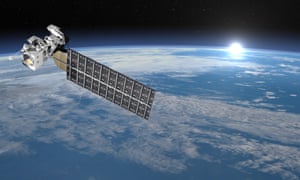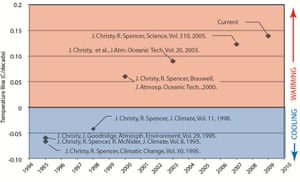Extract from The Guardian
A new study suggests there are remaining biases in the oft-corrected University of Alabama at Huntsville atmospheric temperature estimatesAqua satellite in space orbiting Earth. Photograph: Alamy Stock Photo
John Abraham
Thursday 11 May 2017 20.00 AEST
Human emission of heat-trapping gases is causing the Earth to warm. We’ve known that for many decades. In fact, there are no reputable scientists that dispute this fact. There are, however, a few scientists who don’t think the warming will be very much or that we should worry about it. These contrarians have been shown to be wrong over and over again, like in the movie Groundhog Day. And, a new study just out shows they may have another error. But, despite being wrong, they continue to claim Earth’s warming isn’t something to be concerned about.
Perhaps the darlings of the denialist community are two researchers out of Alabama (John Christy and Roy Spencer). They rose to public attention in the mid-1990s when they reportedly showed that the atmosphere was not warming and was actually cooling. It turns out they had made some pretty significant errors and when other researchers identified those errors, the new results showed a warming.
To provide perspective, we know the Earth is warming because we can measure it. Most of the heat (93%) goes into the oceans and we have sensors measuring ocean temperatures that show this. We also know about warming because we have thermometers and other sensors all over the planet measuring the temperature at the surface or in the first few meters of air at the surface. Those temperatures are rising too. We are also seeing ice melting and sea level rising around the planet.
So, the evidence is clear. What Christy and Spencer focus on is the temperatures measured far above the Earth’s surface in the troposphere and the stratosphere. Generally, over the past few decades these two scientists have claimed the troposphere temperatures are not rising very rapidly. This argument has been picked up to deny the reality of human caused climate change – but it has been found to be wrong.
What kinds of errors have been made? Well first, let’s understand how these two researchers measure atmospheric temperatures. They are not using thermometers, rather they are using microwave signals from the atmosphere to deduce temperatures. The microwave sensors are on satellites which rapidly circle the planet.
Some of the problems they have struggled with relate to satellite altitudes (they slowly fall over their lifetimes, and this orbital decay biases the readings); satellite drift (their orbits shift east-west a small amount causing an error); they errantly include stratosphere temperatures in their lower atmosphere readings; and they have incorrect temperature calibration on the satellites. It’s pretty deep stuff, but I have written about the errors multiple times here, and here for people who want a deeper dive into the details.
It’s important to recognize that there are four other groups that make similar measurement estimates, so it’s possible to compare the temperatures of one group against another. The new paper, completed by Eric Swanson and published by the American Meteorological Society compares the results from three different groups. He focused on measurements made over the Arctic region. His comparison found two main differences amongst the three groups that suggests the errors.
To better appreciate the issues, the satellites have instruments called Microwave Sounding Units (MSUs) or more recently, Advanced Microwave Soundings Units (AMSUs). These instruments allow reconstruction of the lower troposphere (TLT), the mid-troposphere temperature (TMT), and the lower stratosphere temperature (TLS). But the measurements are not at a specific location (like a thermometer) - they are smeared out over large spaces. As a consequence, it’s possible to have one layer of the atmosphere contaminate the results of another layer. You wouldn’t for instance, want your measurement of the troposphere (lower atmosphere) to include part of the stratosphere (above the troposphere).
Among the key differences among the research teams are their methods to ensure this contamination is minimized. According to the recent paper, which was published in January 2017:
At present, the UAH v6 (most recent Christy/Spencer data) results are preliminary and a fifth revision has now been released as v6beta5 (Spencer 2016). The release of the UAH version 6 products before publication is unusual, and Spencer recently stated that a manuscript has been submitted for a peer-reviewed publication. While some may find it scientifically inappropriate to utilize UAH v6b6 data before publication, these data have already been presented in testimony during congressional hearings before both the U.S. House and Senate and have also appeared on websites and in public print articles.The author compared the Christy/Spencer data (UAH data) with another group (the RSS group) and found that the results diverged during the 1986-1988 time period. This shift “could arise from a step change or bias in either series.” When the author compared UAH with the third group (NOAA), the difference was still evident. However, when he compared RSS to NOAA, there was hardly a difference.
The author also noted that the timing of this divergence coincided with the merging of a new satellite NOAA-9, and this satellite has previously been identified as a source of error in the UAH results. But the author continued the analysis to more recent times and found another anomaly in 2005 which has since been corrected in NOAA.
Look, measuring temperatures from satellites flying high above Earth is hard. No one doubts that. But let’s not be deluded into thinking these satellites are more accurate than thermometers (as some people suggest). Let’s also not blindly accept low-ball warming information from research teams that have long histories of revising their data. I created the image below a few years ago to show the upward revisions made by the Christy/Spencer team over time in their global troposphere temperatures.
University of Alabama at Huntsville
estimates of the atmospheric temperature trend before and after
correcting for various errors. Illustration: John Abraham
It is relevant to be reminded of these revisions; had we believed
there results from the 1990s, we’d still think the world was
cooling, and we’d still be wrong.

No comments:
Post a Comment